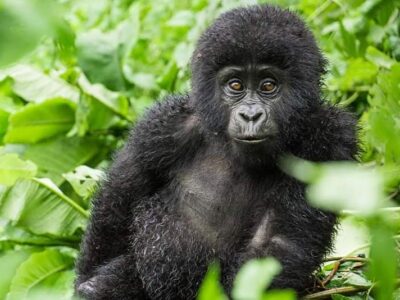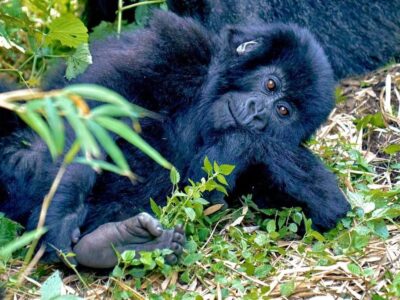How Difficult Is Gorilla Trekking In Rwanda Volcanoes National Park?
How difficult is gorilla trekking in Rwanda?
The gorilla trekking experience in Rwanda avails a mixture of difficulties and advantages. While the difficulties differ per the elements like age, level of fitness, group assignment, terrain, weather, and altitude. The encounter offers an extraordinary golden opportunity to associate with these gentle giants in their natural environment. So, in case you are all set to snuggle the eagerness and wonder of meeting the gorillas at a close range, you should not let the potential difficulties discourage you.
Understanding how challenging a gorilla trek in Rwanda can be.
One frequently asked question emerges when organizing gorilla trekking safaris in Rwanda. Is gorilla trekking difficult? A gorilla trekking safari in Rwanda can be difficult even though the experience can differ generally depending on different factors. Based on the conditions, the trek is very likely to be challenging throughout the jungle or a more relaxed and entertaining stroll.
Mountain gorillas reside in dense wilderness with unequal landscapes, high humidity, and elevations stretching out to 3,000 meters. While the expedition to come into contact with the gorillas in Rwanda can be challenging, it is accomplishable for travelers with average physical fitness. Guides many times clear small obstacles with pangas through the thick jungle and there is help available from porters to maneuver the hardest sections of the forest. Expect to get muddy and sweaty in the course of the hike. We highly advise spending a day or some days in Kinigi to adapt to high altitudes before beginning your gorilla trek. In this article, we take a look at several factors that impact the level of difficulty you might face during a Rwanda gorilla trek.
Gorilla trekking stages in Volcanoes National Park
The journey to see mountain gorillas in Rwanda can be broken down into two main parts. The first part requires walking 30 to 60 minutes from the closest parking area to the park’s boundary. The time taken usually on the speed of the trekkers and the location of the gorilla family they have been assigned.
The second part is the trek in and out of the forest to locate the gorillas. These mountain gorillas are usually tracked ahead of time by scouts who hang around the gorillas and forward back whereabouts bearings to your team. This portion of the journey can take anywhere from 10 minutes to two hours. On average for groups near the edge of the forest, it takes around 20 to 30 minutes.
The first part is fairly effortless to forecast. In general, it is entirely leveled and not too challenging excluding the more difficult uphill climb to arrive at the Susa group. Nonetheless, the second part is more unforeseeable. It depends on where the gorillas are and the steepness of the terrain.
The thickness of the vegetation also plays an important role. Trekkers be might required to bend, crawl, and find their way through the jungle especially when dealing with sharp nettles. The weather adds another layer of complexity. If it has rained recently, the ground can be muddy and slippery.
Fitness Levels and Age Considerations
It’s important to recognize that your age and fitness level play a crucial role in discovering the level of difficulty of gorilla trekking in Rwanda. This is extremely worthy of note on condition that you are allocated the most challenging group which is the Susa Family. Apart from the Susa Group, moderately fit clients who are also under the age of 40 normally do not face remarkable challenges. Nevertheless, it is noteworthy that numerous trekkers are between the ages of 50 and 60 which can make the hike more demanding for them.
Even if you are an individual who bikes daily, do not underrate the stubbornness of a gorilla trek in Rwanda. You may still be required to take regular rests due to the effects of high-altitude breathing. So, clients are advised to spend a day or two outside the park to get adapted to the environment.
While the gorilla trek can be quite challenging, especially for older travelers, it’s quite rare for them to feel so overwhelmed that they decide to turn back. The experience is very motivating, and people usually push through the difficulties.
Location of gorilla groups in Rwanda
One of the major elements that decide the level of difficulty of gorilla trekking in Rwanda how is the specific gorilla group you are allocated to. As a general directive, the hike to arrive at the Susa Group is usually the most challenging as well as the most satisfying as it is home to around 19 members. However, the Sabinyo group is normally the easiest to access.
Trekking gorillas in groups like Hirwa and Kwitonda, Hirwa is usually relatively easy. In contrast, the hikes to groups like Amahoro and Umubano can be more difficult although not as challenging as the trek to the Susa Group. It is paramount to note that any group might present unforeseen difficulties or be relatively effortless to reach on any given day.
In addition, it is impossible to guarantee in advance the specific gorilla group you will be allocated by the park authorities. Nevertheless, the guides at Kinigi make a responsive attempt to match people with the worthiest group especially if clients communicate their preferences. Typically, clients who often trek the Susa group are the younger and physically fit individuals while the opposite tends to be true for the Sabinyo group.
Challenges of Terrain, Weather, and Altitude
There exist two more key factors to contemplate: the unbalanced terrain and the high altitude.
The weather conditions and the terrain
A large number of visitors who come to see gorillas are acquainted with residing in towns and cities with well-maintained roads and sidewalks. They usually use well-maintained and easy-to-navigate paths on their way back home. Nevertheless, during gorilla trekking, you will come in contact with unidentical and slippery paths due to the changing climate seasons. Putting on waterproof and strong shoes or hiking boots with good traction and ankle support will make a big difference during your trek.
If you find it challenging to deal with these conditions, it’s wise to avoid the rainy seasons, especially from March to May, when the paths can become quite muddy and difficult to traverse.
The high altitude challenges
Altitude is another factor put into consideration. Gorilla trekking in Rwanda happens at elevations of 2,500 to 3,000 meters. Although not high enough to cause altitude sickness, it is still high enough to take away the breath of physically fit individuals more so if their home countries are of lower altitudes. This is especially true for travelers who arrive by air from places with lower altitudes.
Most of Rwanda is located above 1,500 meters in elevation. For travelers with concerns about altitude, it is a great idea to spend several days in the Nyungwe forest area (altitude of 2,000 meters) to adapt to the higher altitudes before going to the Virunga Mountains.
Likewise in case you are traveling by land from other parts of Africa, organizing your Rwanda gorilla trekking safari itinerary to spend some time at medium-high altitudes before the demanding gorilla trek is recommended. For example, in case you are traveling from Kenya, spending not many days in Nairobi (2,300 meters) or the Maasai Mara (1,600 meters) will prepare you better for the higher altitudes of the gorilla habitat than spending time at the coast.
Local guides and helpers or porters
When you begin the gorilla trek, guides will frequently offer you a simple walking stick, not something mass-produced however it can be helpful as an extra support on bumpy and slippery paths. Whether you are transferring photography equipment or a daypack, it is a great idea to hire a porter at an appropriate fee. These porters come from the neighboring communities, hoping to make a buck by offering muscle help. They can lift your day luggage and even assist you solve the demanding sections of the trail.
As soon as you get on the trail, the guide takes the lead pace depending on the slowest person in the group. So, proceed in a leisurely fashion, and do not hesitate to demand breaks whenever you need them. It is paramount to come with and drink enough water and carry some energy snacks with you.
The positive news is that the majority of the people going gorilla trekking in Rwanda find out that the hiking part is more reachable than they predicted. In most cases, any exhaustion you might feel during the trek will fade away with ease when you see the magnificent gentle giants. The excitement of the encounter tends to wipe out the exhaustion!
Conclusion
In conclusion, starting a gorilla trekking adventure in Rwanda presents difficulties and rewards. While the challenges vary based on factors like age, level of fitness, group allocation, terrain, weather, and altitude. The encounter provides an extraordinary golden opportunity to conjoin with these beautiful creatures in their natural habitat.

More About Gorilla Trekking
- Why is gorilla trekking cheap in Uganda?
- Mistakes to avoid while booking gorilla permits
- Closest Airport To See Gorillas in Africa?
- Bwindi Vs Volcanoes National Park
- Gorilla Trekking Rwanda Vs Uganda Vs Congo
- Gorilla Trekking Rwanda Vs Uganda
- Age for Gorilla Trekking in Rwanda & Uganda
- Seeing Gorillas in Uganda, Congo & Rwanda
- Gorilla trekking for the elderly and seniors
- Is Gorilla Trekking worth the money?
- Is It Safe to Trek Gorillas in Rwanda?
- Maximum hours to spend with Gorillas
- Gorilla Trekking with Children & Family
- How Many Days Are Needed for Gorilla Trekking?
- Gorilla Trekking Mistakes To Avoid
- Best time to visit Rwanda for Gorillas
- How Hard Is Gorilla Trekking In Uganda?
- Why Choose Gorilla Trekking in Uganda from Kigali
- Gorilla Trekking on A Budget Cheapest Way to See Gorillas
- How Difficult Is Gorilla Trekking In Rwanda?
